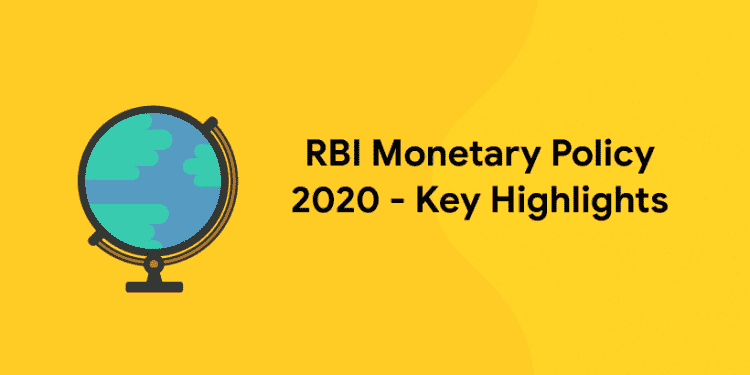Table of Contents
The Indian nation is worried about its economy and future financial outcomes and growth. In this regard it is the duty of the central bank of India, the RBI to revise its monetary policy for the good of the Indian economy. The Monetary Policy Committee (MPC) was constituted on August 4 and released its Monetary policy statement 2020-2021 on August 6, 2020. Let us look into the key features and highlights of the RBI Monetary Policy and its effect on the Indian banking sector and economy and the common people of India.
Monetary Policy – A Brief Introduction
For the people who are new to the economic affairs or financial affairs, let us look into the introduction and meaning of the process of monetary policy. The Indian economy is regulated by mainly two processes. One is called fiscal policy and the other is called monetary policy. Fiscal policy is the policy which is formulated by the government of India in the financial matters like tax policies, subsidy policies etc. on the other hand monetary policy is the policy formulated by the central bank of India which is the RBI. The RBI formulates its monetary policy through the Monetary Policy Committee consisting of 6 members comprising 3 members from the RBI officials and three members who all are nominated from the central government. The present composition of the MPC is:
- Governor of the Reserve Bank of India – Chairperson, ex officio – Shaktikanta Das
- Deputy Governor of the Bank in charge of monetary policy — Michael Debrata Patra
- Executive director of the Bank in charge of monetary policy — Janak Raj
- Shri Chetan Ghate, Professor, Indian Statistical Institute (ISI) – Member;
- Professor Pami Dua, Director, Delhi School of Economics – Member;
- Dr. Ravindra H. Dholakia, Professor, Indian Institute of Management, Ahmedabad – Member
The MPC should be constituted at least 4 times in a year and formulates its monetary policy. The monetary policy is carried out by different devices such as interest rate policies ( Repo Rate, Reverse Repo Rate, Bank Rate…etc), Reserve policies ( Cash Reserve Ratio (CRR), Statutory Liquidity Ratio (SLR)…etc) Open Market Operations ( selling and purchasing of bond …etc) in order to regulate the economy in its inflation deflation and growth rate.
Download Entri for Bank Exam Preparation
The Key Highlights of Monetary Policy August 6 2020
1: Who was the first woman President of India?
| Device | Rate |
| Repo Rate | 4.0% (Unchanged) |
| Reverse Repo Rate | 3.35% (Unchanged) |
| Marginal Standing Rate Facility (MSF) | 4.25% |
| Bank Rate | 4.25% |
- The MPC also decided to continue with the accommodative stance (An accommodative stance means a central bank will cut rates to inject money into the financial system whenever needed) as long as it is necessary to revive growth and mitigate the impact of COVID-19 on the economy.
- These decisions are in consonance with the objective of achieving the medium-term target for consumer price index (CPI) inflation of 4 per cent within a band of +/- 2 per cent, while supporting growth.
- MPC has observed the contraction of the global economy that too of the Advanced Economies (AE) like US
- India’s merchandise exports contracted for the fourth successive month in June 2020, although the pace of fall moderated on improving shipments of agriculture and pharmaceutical products.
- Imports fell sharply in June in a broad-based manner, reflecting weak domestic demand and low international crude oil prices
- Domestic financial conditions have eased substantially and systemic liquidity remains in large surplus, due to the conventional and unconventional measures by the Reserve Bank since February 2020. Cumulatively, these measures assured liquidity of the order of ₹9.57 lakh crore or 4.7 percent of GDP.
- ₹1,24,154 crore was injected through open market operation (OMO) purchases.
- The pace of contraction of industrial production, measured by the index of industrial production (IIP), moderated to (-) 34.7 per cent in May from (-) 57.6 percent a month ago, with the easing of lockdowns in different parts of the country.
- The agricultural sector has emerged as a bright spot. The total area sown under kharif crops on July 31 was 5.9 percent higher than the normal area measured by the average over the period 2014-15 to 2018-19. As on July 30, 2020, the live storage in major reservoirs was 41 percent of the full reservoir level (FRL), which bodes well for the rabi season. These developments have had a salutary effect on rural demand as reflected in fertiliser production and sales of tractors, motorcycles and fast moving consumer goods.
Read the Concept Behind the RBI Monetary Policy
Conclusion
The MPC has observed the global economy has become fragile even for the advanced economy like the United States. The Domestic Economy shows different characteristics over different sectors of the economy. The MPC observes clearly that the Covid 19 Pandemic has infected the economy into the downward direction and delightedly economic activity had started to recover from the lows of April-May following the uneven re-opening of some parts of the country in June. But however, surges of fresh infections have forced re-clamping of lockdowns in several cities and states, making the economy into tension. Let us hope the new monetary policy can revive the economy amidst the pandemic inflected tensions in the economy.














